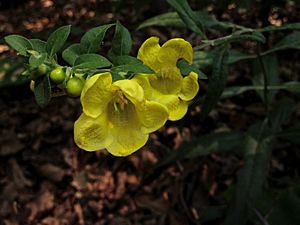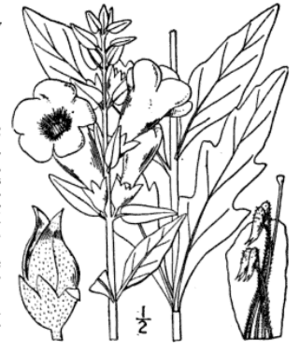Downy yellow false foxglove facts for kids
Quick facts for kids Downy yellow false foxglove |
|
|---|---|
 |
|
| Scientific classification | |
| Genus: |
Aureolaria
|
| Species: |
virginica
|
| Synonyms | |
|
Agalinis glauca (Eddy) S.F.Blake |
|
The downy yellow false foxglove, also known as Aureolaria virginica, is a beautiful plant that grows back year after year. It is native to the eastern parts of the United States and Canada. This plant produces bright yellow flowers during the summer months.
Contents
What Does the Downy Yellow False Foxglove Look Like?
The downy yellow false foxglove can grow quite tall, usually between 50 and 150 centimeters (about 1.5 to 5 feet). Its stems and leaves are covered in soft, fine hairs, which is why it's called "downy."
Its leaves are shaped like an egg or a spear. They are typically 6 to 15 centimeters (about 2.5 to 6 inches) long. The leaves closer to the ground might have small bumps or jagged edges.
The plant's yellow flowers grow on short stalks. Each flower has five petals that are joined together to form a tube. These petals are smooth on the outside and measure about 3.5 to 4.5 centimeters (about 1.4 to 1.8 inches) long. After the flowers bloom, they produce a dry, egg-shaped fruit. This fruit is about 1 to 1.5 centimeters (about 0.4 to 0.6 inches) long and splits open when it's ready.
Where Does This Plant Grow?
The downy yellow false foxglove is found across many states in the eastern United States. You can find it from Florida up to New England. It also grows in the Canadian province of Ontario.
This plant prefers to grow in dry forests where oak trees are common. It needs the right kind of environment to thrive. Things like new buildings, changes in how land is used, or other plants taking over can make it disappear from an area. In New Hampshire, this plant is considered "threatened," meaning it's at risk of disappearing.
How Does This Plant Live?
The downy yellow false foxglove is a very interesting plant because it is a hemiparasite. This means it's a bit like a parasite, but not entirely. It gets some of its food and water from other plants, specifically oak trees. It might even prefer to get its nutrients from a specific type of oak tree called the white oak.
Even though it gets help from oak trees, this plant also has chlorophyll. This is the green stuff in plants that helps them make their own food using sunlight, a process called photosynthesis. So, it's not fully dependent on other plants; it can make some of its own food too!
How Did This Plant Get Its Name?
The downy yellow false foxglove belongs to a group of plants called Aureolaria. Scientists used to think this group was part of the figwort family. However, more recent studies have shown it belongs to a different family called Orobanchaceae.
The famous scientist Carl Linnaeus first described this plant in 1753. He named it Rhinanthus virginicus. Over time, botanists (plant scientists) changed its name several times. This led to some confusion because other similar plants also had changing names.
In the early 1900s, a botanist named Francis W. Pennell cleared up the confusion. He realized that the names had been mixed up by earlier scientists. He made sure the plant got its correct name back, following the rules for naming plants. So, today we know it as Aureolaria virginica.


